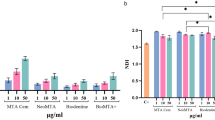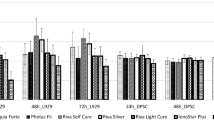Abstract
Zirconia-based ceramics is widely used in dentistry. Different compositions of ceramics have different features. Our self-renovated ceramics become more machinable without scarifying its dental restoration properties after adjusting ratio of lanthanum phosphate (LaPO4)/yttrium oxide (Y2O3). In order to evaluate its safety, here, we tested its genotoxicity in primary human peripheral lymphocytes. The human lymphocytes cultured on three groups of different ratios of LaPO4/Y2O3 diphase ceramics for 6 days showed little effect of growth inhibition and similar effect of growth trend to the negative control. Furthermore, single-cell gel electrophoresis (comet assay) indicated that there was no significant difference of the value of tail moment between the tested ceramics and negative control, the IPS Empress II (P > 0.05). Our findings implicate that our self-renovated ceramics do not induce DNA damages in human peripheral lymphocytes and support their future clinic application.



Similar content being viewed by others
References
Giordano, R. A. (1996). Dental ceramic restorative systems. Compendium Continuing Education in Dentistry, 17, 779–794.
Blatz, M. B. (2001). Long-term clinical success of all-ceramic posterior restorations. Quintessence Dental Technology, 24, 41–55.
McLaren, E. A. (1998). All-ceramic alternatives to conventional metal-ceramic restorations. Compendium Continuing Education in Dentistry, 19, 307–325.
Grossman, D. G. (1972). Machinable glass-ceramics based on tetrasilicic mica. Journal of the American Ceramic Society, 55(9), 446–449.
Barsoum, M. W. (1996). T El-Raghy. Synthesis and characterization of a remarkable ceramic: Ti3SiC2. Journal of the American Ceramic Society, 79(7), 1953–1956.
Padture, N. P., Evans, C. J., Xu, H. H. K., et al. (1995). Enhanced machinability of silicon carbide via microstructural design. Journal of the American Ceramic Society, 78(1), 215–217.
Yamakawa, A., & Kawai, C. (1998). Machinability of high-strength porous silicon nitride ceramic. Journal of the Ceramic Society Japan, 106(11), 1135–1137.
Davis, J. B., & Marshall, D. B. (1998). Machinable ceramics containing rare-earth phosphates. Journal of the American Ceramic Society, 81(8), 2169–2175.
Fenech, M. (2000). The in vitro micronucleus technique. Mutation Research, 455, 81–95.
McKelvey-Martin, V. J., Green, M. H. L., Schmezer, P., Pool-Zobel, B. L., De Méo, M. P., & Collins, A. (1993). The single cell gel electrophoresis assay (comet assay): A European review. Mutation Research, 288, 47–63.
Singh, N., McCoy, M., Tice, R., & Schneider, E. (1988). A simple technique for quantification of low levels of DNA damage in individual cells. Experimental Cell Research, 175, 184–191.
Tomsia, A. P., Lee, J. S., Wegst, U. G., & Saiz, E. (2013). Nanotechnology for dental implants. International Journal of Oral & Maxillofacial Implants, 28(6), e535–e546.
Miyazaki, T., Nakamura, T., Matsumura, H., Ban, S., & Kobayashi, T. (2013). Current status of zirconia restoration. Journal of Prosthodontic Research, 57(4), 61–236.
Owen, C. P. (2012). On form and function in all-ceramic restorations. Journal of the South African Dental Association, 67(7), 400–404.
Kelly, J. R., & Benetti, P. (2011). Ceramic materials in dentistry: Historical evolution and current practice. Australian Dental Journal, 56(Suppl 1), 84–96.
Al-Amleh, B., LYons, K., & Swain, M. (2010). Clinical trials in zirconia: A systematic review. Journal of Oral Rehabilitation, 37(8), 641–652.
Manicone, P. F., Rossi Iommetti, P., & Raffaelli, L. (2007). An overview of zirconia ceramics: Basic properties and clinical applications. Journal of Dentistry, 35(11), 819–826.
Jayaswal, G. P., Dange, S. P., & Khalikar, A. N. (2010). Bioceramic in dental implants: A review. The Journal of Indian Prosthodontic Society, 10(1), 8–12.
Alizadeh, P., Eftekhari Yekta, B., & Javadi, T. (2010). Preparation of machinable bioactive mica diopside-fluoroapatite glass-ceramics. Advances in Applied Ceramics, 109(1), 56–61.
Speit, G., Hanelt, S., Helbig, R., Seidel, A., & Hartmann, A. (1996). Detection of DNA effects in human cells with the comet assay and their relevance for mutagenesis. Toxicology Letters, 88, 91–98.
Author information
Authors and Affiliations
Corresponding author
Rights and permissions
About this article
Cite this article
Hua, N., Zhu, H., Zhuang, J. et al. Genotoxicity Test of Self-Renovated Ceramics in Primary Human Peripheral Lymphocytes. Cell Biochem Biophys 70, 1773–1777 (2014). https://doi.org/10.1007/s12013-014-0127-x
Published:
Issue Date:
DOI: https://doi.org/10.1007/s12013-014-0127-x




